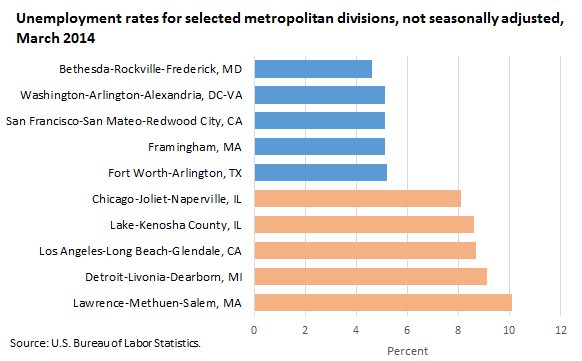An official website of the United States government
 United States Department of Labor
United States Department of Labor
Unemployment rates were lower in March than a year earlier in 333 of 372 metropolitan areas, higher in 30 areas, and unchanged in 9 areas. Twenty-five areas had jobless rates of at least 10.0 percent and 59 had rates of less than 5.0 percent. The national unemployment rate in March 2014 was 6.8 percent, not seasonally adjusted, down from 7.6 percent a year earlier.

| Metropolitan division | Unemployment rate(p) |
|---|---|
Bethesda-Rockville-Frederick, MD | 4.6 |
Framingham, MA | 5.1 |
San Francisco-San Mateo-Redwood City, Ca | 5.1 |
Washington-Arlington-Alexandria, DC, VA | 5.1 |
Fort Worth-Arlington, TX | 5.2 |
Chicago-Joliet-Naperville, IL | 8.1 |
Lake-Kenosha County, IL | 8.6 |
Los Angeles-Long Beach-Glendale, CA | 8.7 |
Detroit-Livonia-Dearborn, MI | 9.1 |
Lawrence-Methuen-Salem, MA | 10.1 |
| Footnotes:
(p) Preliminary.
| |
Eleven of the most populous metropolitan areas are made up of 34 metropolitan divisions, which are essentially separately identifiable employment centers. In March, Lawrence-Methuen-Salem, Massachusetts-New Hampshire had the highest jobless rates among the divisions, 10.1 percent. Bethesda-Rockville-Frederick, Maryland had the lowest division rate, 4.6 percent.
These metropolitan area data are from the Local Area Unemployment Statistics program and are not seasonally adjusted. To learn more, see “Metropolitan Area Employment and Unemployment — March 2014” (HTML) (PDF), news release USDL-14-0699.
Bureau of Labor Statistics, U.S. Department of Labor, The Economics Daily, Metropolitan area unemployment in March 2014 at https://www.bls.gov/opub/ted/2014/ted_20140501.htm (visited January 01, 2026).

